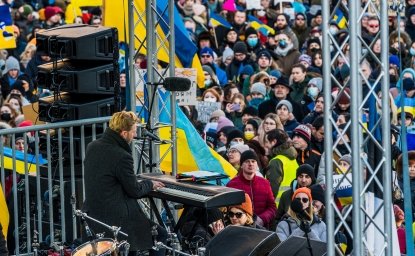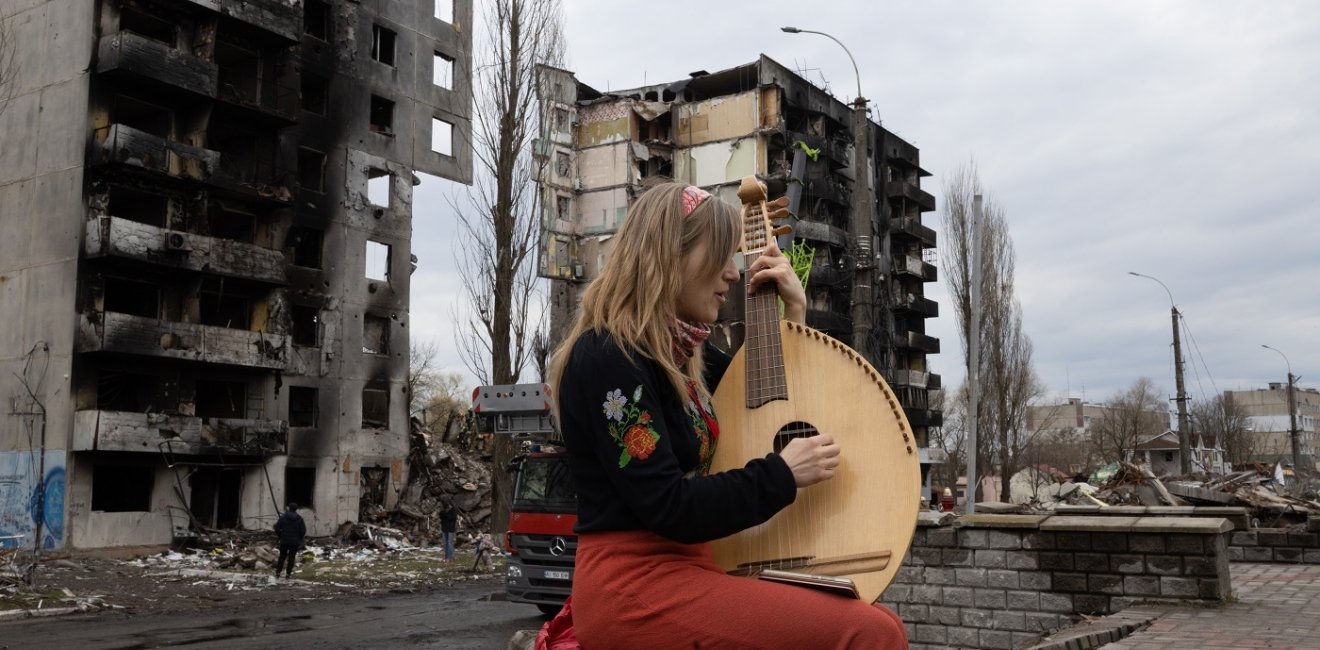
A blog of the Kennan Institute
This article is an overview of Blair Ruble’s series The Arts of War: Ukrainian Artists Confront Russia, which has run in Focus Ukraine since the start of Russia’s full-scale invasion of Ukraine in February 2022.
Today’s Ukraine, like all states, is a product of history, economics, geography, demographics, and culture. As is often the case with large countries, Ukraine has at times fractured along these lines. As is also often true with large countries, such divisions do not necessarily destroy the state.
Heroically, Ukrainians have demonstrated a steadfast commitment to Ukraine despite all the factors that may distinguish them one from another, and they have not left their country’s fate to the actions of others. They have put their lives on the line multiple times for a Ukraine that embraces a pathway westward.
For many analysts, Ukraine prior to 2022 appeared to be a “failed” state. Divisions of language, ethnicity, religion, economic viability, political ideology, and generation—amplified by rampant corruption—seemed at times to render Ukraine hopeless. Only Leonid Kuchma, the first of the country’s five presidents since independence, managed re-election. Political parties came and went seemingly overnight. Major civil unrest brought down governments with the Orange Revolution (2004–2005) and the Euromaidan Revolution of Dignity (2014–2015). Breakaway provinces in the east and the Russian annexation of Crimea initiated a protracted war with Russia in 2014. These events seem to track a fundamental historic division along what was once the eastern border of the Polish-Lithuanian Commonwealth (1385–1795).
As powerful as these events have seemed, none explain the past year in Ukraine. No matter what Vladimir Putin and his armed forces have done, Ukrainians have remained united and unwavering in their commitment to their country. We must look beyond politics to the arts to appreciate how and why this has been so.
Over the past 30 years, young Ukrainians have grown up with no memory of the Soviet Union; secure in the notion that Russia is a different—and unattractive—country; fluent in the Ukrainian language even if they speak Russian, Tatar, or some other language at home; and drawn to the economic well-being and values of Europe. They have created a vibrant, new Ukrainian culture and identity. The effervescent Ukrainian pop music and hip-hop scene, accompanied by sassy media and dynamic art, reflect a population that has charted a fresh path following independence. This is a Ukraine that coalesced to withstand Putin’s misguided efforts to fold the country back into his “Russian World.” (Multiple “Russias” exist within the Russian Federation as well, but that is a topic for a different essay.)
Russian apologists have pointed to electoral maps from the 2000s and 2010s to demonstrate that Ukraine is a divided state. In so doing, they have ignored the country’s foundational map showing the results of the 1991 referendum on independence, in which over 91 percent of eligible voters cast their ballots for independence, with landslide results in every region. More telling is the 2019 presidential election map, which shows Volodymyr Zelensky sweeping to victory throughout the country.
Analysts disparaged Zelensky’s remarkable triumph, comparing it unfavorably with the elections of Silvio Berlusconi in Italy and Donald Trump in the United States. Like his Italian and American counterparts, they argued, Zelensky won because of the name recognition garnered through his starring role in a popular television show, Servant of the People. Perhaps this was so, but the show’s popularity throughout the country reveals the emergence of a single Ukrainian-language media space which enabled Zelensky to win fans across Ukraine.
The essays to follow highlight the ways in which Ukrainians have long explored the meaning of their country and culture through the arts, and the manner in which the arts and their creators have empowered Ukrainians to confront the Russian invaders. This shared post-independence cultural exploration nurtured the foundation of a successful, rather than a failed, state.
The essays grew organically out of the response to the war itself. They show Ukraine’s creative community leading the way towards a united Ukrainian culture consisting of diverse elements. They reflect the wide variety of cultural forms and regional variance that marks the country itself.
Three major themes run through the stories to follow:
Russia is not Ukraine. Almost immediately following the arrival of Russian occupation forces, the Ukrainian letter “Ï” (“ee”, as in “Kиїв”) assumed an expanded meaning. The Cyrillic letter “Ï” exists in the Ukrainian, but not the Russian, alphabet. The letter became a potent symbol of resistance in Russian-occupied territories, easily splashed on walls, pavements, and official signage as its existence denies the notion that Ukraine is nothing more than a subset of Russia.
Ukrainian and Russian alphabets share many letters while not being identical. Similarly, the languages and cultures share considerable history. Russian influence on Ukraine—some of it welcomed, much of it not—can neither be denied nor “cancelled.” Yet that influence was filtered through experiences distinct to Ukraine and Russia. The result has been differing experiences, values, and conceptions of the human condition. Ukraine and its culture cannot be subsumed within a grandiose and false concept of a “Russian world.” As the essays presented here reveal, Ukraine is not Russia. Ukrainians appreciate such difference, embrace it, and, through artistic expression, have sought to strengthen it.
Youth culture matters. Over the past three decades, young Ukrainians have created a lively and distinctive popular culture through music—including their own brand of hip-hop—and social media. Ukrainian youth culture has triumphed over internal differences across the country. Ukrainian has been the language of that culture. Whether cultivated by official and commercial outlets—The Simpsons appeared in Ukrainian rather than Russian translation—or homegrown social media-produced formats—this new culture has remained, first and foremost, fun.
Several of the articles presented here demonstrate how a distinct Ukrainian youth culture extends throughout the country, reshaping the society and its culture. As some Russian-language rappers from Eastern Ukraine came to realize, the Russian scene was considerably less relevant and compelling than what was happening throughout the rest of Ukraine. They switched to relying on Ukrainian for self-expression because it better communicated their emotions and world view, rather than out of any sort of political agenda.
Art endures; politics are fleeting. Renowned tango historian Robert Farris Thompson once observed that culture is forever; it is politics and ego that fade. The search for understanding of the human condition, shared identity and values, and creative expression evident in all of the stories presented here point to a contemporary Ukraine programmed to resist and to sustain itself in the face of the Russian onslaught. Ukrainians have created their own unique society and culture to be shared with other Ukrainians. That culture’s individual components may at first appear modest, but combined, they have emerged as heroic. The arts have reshaped the course of Ukrainian history and will frame the country’s future as well.
The Ukrainian response to the 2022 Russian invasion has inspired a new appreciation for the country, both within and beyond Ukraine. The steadfastness of Ukrainians in the defense of their country has surprised many. The stories presented here highlight the ways in which Ukrainians have long explored the meaning of their country and culture through the arts. They show the manner in which the arts and their creators have empowered Ukrainians to confront the Russian invaders. These developments also offer intriguing clues about the culture, society, and politics of a post-war Ukraine.
The opinions expressed in this article are those solely of the author and do not reflect the views of the Kennan Institute.
Author

Former Wilson Center Vice President for Programs (2014-2017); Director of the Comparative Urban Studies Program/Urban Sustainability Laboratory (1992-2017); Director of the Kennan Institute for Advanced Russian Studies (1989-2012) and Director of the Program on Global Sustainability and Resilience (2012-2014)

Kennan Institute
The Kennan Institute is the premier US center for advanced research on Eurasia and the oldest and largest regional program at the Woodrow Wilson International Center for Scholars. The Kennan Institute is committed to improving American understanding of Russia, Ukraine, Central Asia, the South Caucasus, and the surrounding region through research and exchange. Read more

Explore More in Focus Ukraine
Browse Focus Ukraine
The Arts of War: Ukrainian Artists Confront Russia

Talking to the Dead to Heal the Living

Ukrainian Issue in Polish Elections

